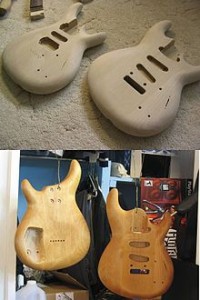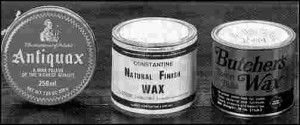We’re often asked which products to use for their bamboo finishing.
So here we have a guideline for you to follow when finishing your bamboo countertop or bamboo plywood project.
Preparation
Preparation is always the most critical step in any bamboo finishing application, get that wrong and the quality and durability of your finish is drastically reduced.
The first step is to give the surface a light sand just to remove the grime.
Bamboo finishing – oil
Oil is one of the most traditional finishes used.
Oils do not provide as much protection as the more modern finishes e.g. varnish. Oil finishes however, bring out the natural beauty of bamboo boards and counter tops. If you want to stain your bamboo prior to oiling it, use a water-based stain. Oil-based dyes will clog-up the bamboo’s “pores”, stopping the oil finish from soaking in effectively.
One complaint regarding an oil finish, is that sometimes, when paper is left on the surface for a while the oil is soaked into the paper. This can sometimes be caused when you have stained the bamboo surface before applying the mineral oil. In these cases, ensure you use a water based stain. You may also need to allow the oil to soak in for a much longer period. Ensure you buff the surface very well, as this can also minimise oil soaking into paper. You can add a coat of oil based beeswax to the surface to prevent this type of problem.
We don’t recommend using vegetable oil as it eventually turns rancid.
Mineral oil
Mineral oil is a great food-safe option, so is great if you plan to prepare food on your bamboo top or bamboo cutting board. The mineral oil will feed the bamboo and help protect it from drying out and splitting or cracking.
Heavily oil the countertop (as in puddles of mineral oil) and let it soak into the bamboo overnight.
Rub the mineral oil in, against the grain. Allow approximately 24 hours between each coat. When you are finished, wipe down all excess oil from the surface with a clean cloth and then buff the surface.
You will need to apply a little mineral oil every so often (depending on usage) to keep the surface in top condition – think of it as applying your regular coat of furniture spray. If you continuously use chemical cleaners, you will need to increase the frequency of application.
Linseed Oil
Linseed oil finishes are are great for indoor applications, especially older projects needing refinishing. We don’t recommend you do not use it for outdoor applications.
Raw linseed oil takes a long time to penetrate the bamboo or any wood surface (expect 2-3 days per coat). Boiled linseed oil will penetrate much quicker, whereas raw linseed oil will provide better protection to the bamboo.
You will need to apply a number of coats to achieve a satisfactory finish with linseed oil.
Apply the linseed oil with a cloth and rub well into the bamboo. Leave at least 2-3 days for raw linseed oil and 24 hours for boiled linseed oil between applications. Once you are happy with the finish, buff with a soft cloth.
Tung Oil
 Tung oil hardens (dries) upon exposure to air. Of all the finishes, tung oil is the easiest and most durable finish.
Tung oil hardens (dries) upon exposure to air. Of all the finishes, tung oil is the easiest and most durable finish.
The surface finish provided by tung oil is waterproof, impervious to dust, alcohol, acetone, fruit and vegetable acids. Tung oil does not darken with age as does linseed oil and wax.
Tung oil is flexible, so can withstand the movement of bamboo, without cracking or checking. Tung oil soaks into the pores of the bamboo, sealing the moisture in the bamboo. It also provides a good coating on the surface of the bamboo furniture, giving a soft sheen finish.
Apply the tung oil liberally with a brush, a cloth or pour some on the surface and spread it around until the whole surface is covered equally. Allow about 10 minutes for the tung oil to penetrate the bamboo surface. If there are any dull spots on the bamboo, add a little more tung oil to that area. The dull spot occurs when the bamboo has absorbed all the tung oil. Once the tung oil has soaked into the bamboo, wipe the excess off with a cloth.
We don’t recommend you let the excess tung oil dry on the surface, as you’ll have created yourself a bit of extra work cleaning it off as it gets very tacky.
Additional coats of tung oil will build a good protective surface coat. Allow at least 24 hours before adding the next coat, each coat will add to the sheen and increase the protection it provides to the bamboo.
Three to four coats are enough for vertical surfaces or furniture that doesn’t get much use. Horizontal surfaces, such as table tops should have six to ten coats to achieve a strong and durable finish.
Once the final coat is dry, if you want the surface to have a smooth finish, give it a rub with steel wool and clean with a tack cloth. Always rub in the direction of the grain.
Whilst tung oil isn’t as hard as a lacquer finish, it is much easier to repair if the surface is damaged.
If you plan to use tung oil on a surface where you plan to prepare food, only use 100% raw tung oil. This variety of tung oil is slightly more difficult to apply that the tung oil finishes that have been thinned using solvents.
Tung oil is also known as Chinawood oil.
Teak oil (including Danish)
Both teak oil and Danish oil provide a more durable finish than linseed oil and are most suited to new projects.
These oils can be applied using a soft cloth or brush. As opposed to mineral oil (where one soaks the surface with oil), apply a light coat of the oil at a time – these oils do not soak into the bamboo. Lightly sand between each coat using a fine silicon-carbide paper.
Four coats of oil should provide the desired finish.
Bamboo finishing – wax
Beeswax
 Beeswax is food-safe, so is an option for use on a surface wherever food is prepared. Strictly limited to indoor applications.
Beeswax is food-safe, so is an option for use on a surface wherever food is prepared. Strictly limited to indoor applications.
Beeswax is available in a blended format with an oil or as a paste.
We do not recommend beeswax as a protective finish on surfaces that will be handled or are exposed to daily wear and tear. The protection provided by beeswax is minimal.
Typical use of beeswax paste is as a polish over an existing finish such as lacquer, varnish, shellac, polyurethane or even oil finishes. Beeswax oil finish is more suited for a carved or turned object that does not receive much handling.
Follow the instructions of the container for best results. With the beeswax paste, you will need to rub it in along the grain for the best result. An extra coat will be required approximately every month – once again think of it as applying your regular coat of furniture spray.
Do not use solvent based beeswaxes on water based finishes
Bamboo finishing – commercial varnishes
Varnish
Wood varnishes provide a very good and durable finish that seals in the moisture in your bamboo. The only possible problems you may experience will be cracking or peeling – and this can usually be avoided by good preparation of the surface before application and following the manufacturers instructions closely.
Varnishes are available in oil based and water based finishes, from satin smooth to shiny gloss finishes.
Varnishes are applied using brushes. We recommend you get higher quality brushes as digging brush hairs out can be a real pain.
After each coat has been evenly applied, simply buff it down to prepare it for the next coat. It is very important that you apply the same number of coats to each surface of the bamboo to ensure even absorption and loss of moisture as the bamboo “breathes”.

Hello. What finish would you recommend to protect an outdoor bamboo sun lounge please. I am in South Australia.
Thank you.
Kind regards, Jessie